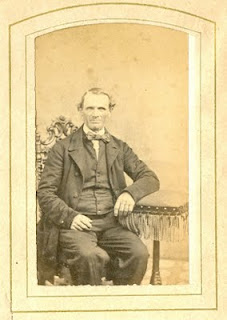 |
| Isaac Eastburn (1806-1890) |
Just south of Corner Ketch, and north of the Paper Mill Road/Polly Drummond Hill Road intersection, there's a small little stub of a street called Pigeon Hollow Road. There are only about three or four houses on the street, but two of them are survivors from the era when the Eastburns controlled the region. There is a two-story stone house, with a large, newer addition on the rear; next to it is a longer, 1 1/2 story frame house. This second house, for much of the second half of the 1800's, was the site of the Eastburn Store (I don't know that that was what it was called, but that's how I'll refer to it).
As best as we can tell (much of the information comes from Eastburn descendant Donna Peters), the first proprietor of the store was Isaac Eastburn (1806-1890), a son of David Eastburn, co-founder of the Eastburn-Jeanes Lime Kilns. When he first opened his shop is unclear, except that by the 1860 census he was listed as a store keeper. (I couldn't find Isaac in the 1850 census.) Since it appears that the stone house may be older than the store (now also a house), Isaac likely farmed his portion of the family land for a while before becoming a store keeper, and may have even continued doing both. Interestingly, the proprietor of the store just up the road at Corner Ketch was Samuel Lloyd. Isaac and Samuel were brothers-in-law twice over -- Isaac was married to Mary Lloyd, and Samuel's wife was Rebecca Eastburn. I wonder whether Isaac opened his store to compete with his brother-in-law, or whether there was cooperation between the shops?
 |
| Front of Eastburn's Store |
One of the biggest mysteries in this story seems to be, just exactly who did buy Isaac's land? There are two possibilities, and each makes sense in its own way. The prevailing wisdom was that it was Isaac's son, Samuel L. Eastburn (1834-1900). Sounds logical that he would sell to his son, but if so, Samuel didn't stick around long. The 1870 and 1880 censuses both show Samuel L. in Wilmington, first as a store clerk, then as a liveryman. An 1874 directory lists him as having a livery stable on French Street. Whether or not it was he who bought his father's land, Samuel L. Eastburn almost certainly did not operate the store -- at least not for long.
 |
| Samuel L. Eastburn |
Regardless of who bought the land, it seems obvious that neither one actually ran the store. So, who did? My best guess, based on the evidence I've seen, is that the man who operated the store after Isaac's departure was another of his brothers -- Isaiah Eastburn (1810-1891). As a younger man, Isaiah owned a farm farther south on Polly Drummond Hill Road, near Old Coach Road. By 1860, he was living near the rest of his family, and was listed as a shoemaker in the 1860 census, and as a bootmaker in 1870. In 1880, his occupation was listed as storekeeper. What seems likely is that Isaiah moved onto Isaac's former property after 1865, and worked both as a shoemaker and as a storekeeper. In fact, the 1874 state directory does list Isaiah as both, as shown below.
I've yet to find out how long the store operated, or if anyone ran it after the passing of Isaiah Eastburn in 1891. Whenever it closed, the old homes on the once-busy Pigeon Hollow Road stand as two more reminders of the time when the Eastburns dominated this region of Mill Creek Hundred.
Thanks for the post Scott! Lots of information and very interesting. Thanks to Donna for the pics. So is it safe to assume the house next to the store was also owned by either David or Samuel Eastburn?
ReplyDeleteThank you. I guess Donna has all my/our family history. She seems to be a wealth of information. Isaac is my 4th great grandfather and I love hearing about him and our family.
ReplyDeleteI'm glad you found us. I always like hearing from descendants of the people I write about. I know there are lots of Eastburns still around (I even worked with one a few years back). I haven't heard from Donna in a while (maybe because I haven't dealt with the Eastburns in a while) but if you want, you can email me at mchhistory@verizon.net and I can forward your information to her. I'm sure she'd be happy to help. I sounds like you're researching your family, but if there are any specific things you need a hand with here and there, I'd be happy to see what I can do, too.
DeleteHi Eastburn cousin unknown, I have an Eastburn Genealogy Facebook group you should join. There are 74 cousins in the group. Rich Morrison
DeleteWhat is your line from Isaac Eastburn? And yes, you should join Rich Morrison's Eastburn Facebook group.
DeleteI actually have been in contact with Rich on Ancestry.com and he is a wealth of information but unfortunately I deactivated Facebook years ago. I live in Pike Creek across from Ebenezer Methodist Church and found several relatives there. Love reading this stories and I will reach out for sure. Amy Eastburn
ReplyDeleteDonna -my line is from Isaac then David who was married Elizabeth Chambers, then John Eastburn who married Anna Macy Pierson, then John Earl Eastburn who married Grace Hawthorne to my grandparents Earl Eastburn and Betty Hutchinson. Amy
ReplyDeleteHi cousin Amy.
ReplyDeleteRich
Hi Rich! I hope you are doing wonderful! Amy
Delete